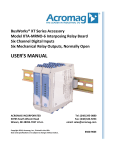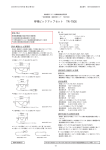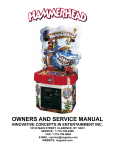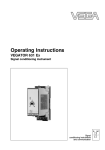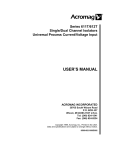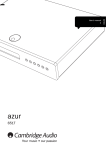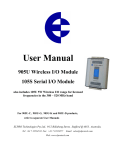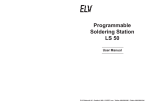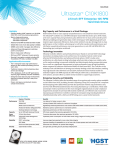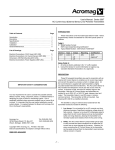Download User`s Manual
Transcript
Series 651T/652T/653T Process Current Two-Wire Transmitter/Isolators USER’S MANUAL ACROMAG INCORPORATED 30765 South Wixom Road P.O. BOX 437 Wixom, MI 48393-7037 U.S.A. Tel: (248) 295-0880 Fax: (248) 624-9234 Copyright 1999, Acromag, Inc., Printed in the USA. Data and specifications are subject to change without notice. 8500-599-F10F018 Series 651T/652T/653T Isolator User’s Manual Process Current Two-Wire Transmitters ___________________________________________________________________________________________ Safety Summary - Symbols on equipment: ! 1.0 INTRODUCTION Means “Caution, refer to this manual for additional information”. These instructions cover hardware functionality of the isolator models listed in Table 1. Supplementary sheets are attached for units with special options or features. Table 1: Models Covered in This Manual Series/Input/Type -Options/Output/Enclosure/Approvals1 651T3 -0600 652T3 -0600 653T3 -0600 The information contained in this manual is subject to change without notice. Acromag, Inc., makes no warranty of any kind with regard to this material, including, but not limited to, the implied warranties of merchantability and fitness for a particular purpose. Further, Acromag, Inc., assumes no responsibility for any errors that may appear in this manual and makes no commitment to update, or keep current, the information contained in this manual. No part of this manual may be copied or reproduced in any form, without the prior written consent of Acromag, Inc. Table of Contents 1.0 INTRODUCTION ………………………………..…….. DESCRIPTION ………………………………………… Key 65xT Features……………..…………………… 2.0 PREPARATION FOR USE ….……………………….. UNPACKING AND INSPECTION …………………… INSTALLATION ……………………………………….. Mounting ……………………………………………… Electrical Connections ……………………………… 3.0 CALIBRATION…………………………………………. TRANSMITTER ADJUSTMENT PROCEDURE……. 4.0 THEORY OF OPERATION ………………………….. 5.0 SERVICE AND REPAIR ……………………………… SERVICE AND REPAIR ASSISTANCE ……………. PRELIMINARY SERVICE PROCEDURE ..…………. 6.0 SPECIFICATIONS ……………………………………. MODEL NUMBER DEFINITION……………………… INPUT SPECIFICATIONS ……………………………. OUTPUT SPECIFICATIONS ………………………… ENCLOSURE/PHYSICAL SPECIFICATIONS..…….. APPROVALS ………………………………………….. ENVIRONMENTAL SPECIFICATIONS …………….. List of Drawings Simplified Schematic (4501-726)……..………………...… Electrical Connections (4501-727, Figure A)…...…..…... Electrical Connections (4501-727, Figure B)..….…..…... Enclosure Dimensions (4501-728).…………………..…… Notes (Table 1): 1. Approvals: CE marked, UL and cUL listed. Hazardous Locations: Class 1; Division 2; Groups A, B, C, D. (See specifications). 2. The unit is calibrated from the factory for 4-20mA I/O only. 3. Model 651T units have one I/O channel, while 652T units provide two I/O channels. Model 653T units combine a single input and two 2-wire outputs to form a signal splitter. Page 2 2 2 3 3 3 3 3 4 4 4 5 5 5 5 5 5 5 6 6 6 DESCRIPTION Series 65xT Isolators are members of Acromag’s vast line of isolators, alarms, and transmitters. These models are simple, low-cost, isolated, two-wire transmitters for process current input signals, in single (651T), and dual (652T) channel configurations. Model 653T units combine a single input with dual isolated 2-wire outputs to form a signal splitter. Zero and span trim adjustments utilize 15-turn potentiometers accessible from the front of the unit. Each channel also includes an LED loop power indicator. These isolators are DIN-rail mounted with removable plug-in type terminal blocks to facilitate ease of installation and replacement, without having to remove wiring. Connectors are an industry standard screw clamp type and accept a wide range of wire sizes. All 65xT isolator modules are designed to withstand harsh industrial environments. They feature RFI, EMI, ESD, EFT, and surge protection, plus low temperature drift, wide ambient temperature operation, and isolation from input-to-output and channel-to-channel. They also have low radiated emissions per CE requirements. The safe, compact, rugged, and reliable design of these isolators makes them an ideal choice for control room or field applications. Page 7 8 9 10 Key 65xT Features IMPORTANT SAFETY CONSIDERATIONS • It is very important for the user to consider the possible adverse effects of power, wiring, component, sensor, or software failures in designing any type of control or monitoring system. This is especially important where economic property loss or human life is involved. It is important that the user employ satisfactory overall system design. It is agreed between the Buyer and Acromag, that this is the Buyer's responsibility. • • • • -2- Fully Isolated - Galvanic isolation is provided from input to output and includes isolation between channels for safety and increased noise immunity. Very Low Input Burden - The input voltage drop of this device is typically less than 1.5V (651T/652T), or 3V (653T). Convenient Two-Wire Loop Power - The output signal and power share the same two-wire connections. Each channel includes an LED to indicate loop power. Output Current Sense Resistor - Each output channel includes a precision, series-connected, 10Ω resistor that may be used to monitor the output loop current via a DVM, without breaking the loop. Wide Ambient Operation - The unit is designed for reliable operation over a wide ambient temperature range. Series 651T/652T/653T Isolator User’s Manual Process Current Two-Wire Transmitters ___________________________________________________________________________________________ Key 65xT Features…continued Mounting • Refer to Enclosure Dimensions Drawing 4501-728 for mounting and clearance dimensions. • Hardened For Harsh Environments - The unit will operate reliably in harsh industrial environments and includes protection from RFI, EMI, ESD, EFT, and surges, plus low radiated emissions per CE requirements. Convenient Mounting, Removal, & Replacement - The DIN-rail mount and plug-in type terminal blocks make module removal and replacement easy. DIN Rail Mounting: This module can be mounted on "T" type DIN rails. Use suitable fastening hardware to secure the DIN rail to the mounting surface. Units may be mounted side-by-side on 1-inch centers for limited space applications. "T" Rail (35mm), Type EN50022: To attach a module to this style of DIN rail, angle the top of the unit towards the rail and locate the top groove of the adapter over the upper lip of the rail. Firmly push the unit towards the rail until it snaps solidly into place. To remove a module, first separate the input terminal block(s) from the bottom side of the module to create a clearance to the DIN mounting area. Next, insert a screwdriver into the lower arm of the DIN rail connector and use it as a lever to force the connector down until the unit disengages from the rail. 2.0 PREPARATION FOR USE UNPACKING AND INSPECTION Upon receipt of this product, inspect the shipping carton for evidence of mishandling during transit. If the shipping carton is badly damaged or water stained, request that the carrier's agent be present when the carton is opened. If the carrier's agent is absent when the carton is opened and the contents of the carton are damaged, keep the carton and packing material for the agent's inspection. For repairs to a product damaged in shipment, refer to the Acromag Service Policy to obtain return instructions. It is suggested that salvageable shipping cartons and packing material be saved for future use in the event the product must be shipped. Electrical Connections Terminals can accommodate wire from 14-24 AWG, solid or stranded. Since common mode voltages can exist on signal wiring, adequate wire insulation should be used and proper wiring practices followed. Input wiring may be shielded or unshielded twisted-pair. Output wires should be twisted pair. Strip back wire insulation 1/4-inch on each lead before installing into the terminal block. It is recommended that output wiring be separated from the input wiring for safety, as well as for low noise pickup. Note that each channel’s terminal block is of a plug-in type that can be easily removed to facilitate module removal or replacement, without removing individual wires. To prevent electric shock, be sure to remove the I/O signal before unplugging the terminals to uninstall the module or before attempting service. All connections should be made with I/O signals removed. This module is physically protected with packing material and electrically protected with an anti-static bag during shipment. However, it is recommended that the module be visually inspected for evidence of mishandling prior to applying power. This circuit utilizes static sensitive components and should only be handled at a static-safe workstation. Power, input, and output I/O wiring must be in accordance with Class 1 Division 2 wiring methods, Article 501-4(b) of the National Electrical Code, NFPA 70, for installations in the U.S., or as specified in Section 18-1J2 of the Canadian Electrical Code for installations within Canada and in accordance with the authority having jurisdiction. INSTALLATION This isolator module is packaged in a general purpose plastic enclosure. Use an auxiliary enclosure to protect the unit in unfavorable environments or vulnerable locations, or to maintain conformance to applicable safety standards. Stay within the specified operating temperature range. As shipped from the factory, the unit has already been calibrated for 4-20mA I/O. To verify calibration, see CALIBRATION section. CAUTION: Risk of Electric Shock - More than one disconnect switch may be required to de-energize the equipment before servicing. WARNING: Explosion Hazard - Substitution of components may impair suitability for Class 1 Division 2. WARNING: Explosion Hazard - Do not disconnect equipment unless power has been switched off or the area is known to be non-hazardous. WARNING: Applicable IEC Safety Standards may require that this device be mounted within an approved metal enclosure or sub-system, particularly for applications with exposure to voltages greater than or equal to 75VDC or 50VAC. 1. DC Current Input (Each Input): Connect input(s) per Drawing 4501-727. Observe proper polarity. Current is delivered to the “IN+” terminal and returned via the “IN-“ terminal. The input voltage drop of this unit is less than 1.5V typical. Reverse polarity protection is included. -3- Series 651T/652T/653T Isolator User’s Manual Process Current Two-Wire Transmitters ___________________________________________________________________________________________ TRANSMITTER ADJUSTMENT PROCEDURE IMPORTANT: Note that input and output circuits are isolated from each other allowing the output circuit to operate with common-mode voltages up to 250VAC, or 354VDC off ground, on a continuous basis. Channels are also isolated from each other. Equipment Required • 2. Output/Power Connections (Each Output): Connect a DC power supply and the load in a two-wire configuration as shown in Electrical Connections Drawing 4501-727. For supply connections, use No. 14-24 AWG wire rated for at least 90° Celsius. Loop current is input to the OUT+ lead and returned via the OUT- lead. Optionally, a DVM may be placed between the “SNS+” terminal and the “OUT-“ terminals to monitor the loop current via the voltage drop measured across a built-in, precision 10Ω resistor connected in series with the “OUT-“ lead. These transmitters operate from DC supplies only. Power supply voltage is not critical and should be from 12-36V DC. The supply voltage must not exceed 60V, even momentarily, or damage to the unit may result. Further, the power supply voltage must be adequate to supply full-scale current to the load(s), plus 12V to the transmitter terminals, plus any transmission line drop. Variations in power supply voltage or load resistance within rated limits has negligible effect on transmitter accuracy. • • An accurate input current source adjustable for 4-20mA DC. This source should be accurate beyond the ±0.1% module specification for best results. An accurate current or voltage meter is also required to monitor the output level. This meter must be accurate beyond the module specifications for best results. A precision load resistance will be needed if you are monitoring output voltage to complete calibration. Adjustment Procedure Note: Zero and Span pots are turned clockwise to increase the output signal, and counter-clockwise to reduce the output signal. 1. Connect the input signal and output power/load as shown in Electrical Connections Drawing 4501-727 for the channel of interest. Two power supplies and loads will be required to calibrate 653T units. 2. Adjust the input signal to precisely 4.000mA DC. Adjust the zero pot until the output reads 4.000mA ±0.016mA DC. Repeat this procedure for the second zero pot and output of 653T units. 3. Adjust the input signal to precisely 20.000mA DC. Adjust the span pot until the output reads 20.000mA ±0.016mA DC. Repeat this procedure for the second span pot and output of 653T units. 4. Repeat steps 2 & 3 until the readings converge. 5. As a check of calibration, adjust the input to precisely 12.000mA and verify the output measurement to within ±0.1% of span. Check both outputs of 653T units. If the measured error is greater than ±0.1%, then perform steps 2 and 3 again until rated accuracy is achieved. 6. Repeat the above procedure for the second channel of 652T units. Ripple & Noise: Power supply ripple at 60Hz/120Hz is reduced at the load by the transmitter. The ripple at the load will generally be less than 0.02% of span per volt peak-topeak of power supply ripple. The unit may have up to 0.25% of additional internally generated ripple. In this case, connect an external 1uF capacitor across the load to reduce this ripple to less than 0.1% if desired. 3. Grounding: See Electrical Connections Drawing 4501-727. The module housing is plastic and does not require an earth ground connection. If the isolator is mounted in a metal housing, a ground wire connection is typically required. Connect the metal enclosure’s ground terminal (green screw) to earth ground using suitable wire and per applicable codes. 4.0 THEORY OF OPERATION WARNING: For compliance to applicable safety and performance standards, the use of twisted pair wiring is recommended as shown in Drawing 4501-727. Failure to adhere to sound wiring and grounding practices as instructed may compromise safety and performance. Refer to Simplified Schematic 4501-726 to gain a better understanding of the circuit. These isolators use a center-tapped transformer to isolate from output to input. Half of the output loop current is routed to a 2:1 transformer (output current:input current) while being driven in an alternating push-pull fashion to modulate the input current. The other half of the output current drives an output circuit supply and is pulled through a current steering circuit that regulates the input current (via the transformer) and an adjustment current (zero and span circuit). The input circuit utilizes a unique mosfet to limit the input voltage drop to low VGS threshold levels. The input circuit also includes overvoltage transient suppression circuitry, noise filtering, and a reverse polarity protection diode. Transient voltage suppressors and other filtering devices are also included at the output for effective noise filtering and transient suppression. The output “OUT-“ lead includes a precision series-connected 10Ω resistor to facilitate the connection of a DVM across the output “SNS” and “OUT-“ terminals for monitoring the output loop current without breaking the loop. 3.0 CALIBRATION Units are calibrated at the factory and further adjustment is not normally required unless the circuit has aged or periodic calibration is needed to meet your company’s maintenance requirements. Calibration is performed as an iterative process of zero and span adjustment for each output channel. The zero and span adjustment potentiometers are accessible from the front panel of the unit. The screwdriver blade used to adjust the potentiometers should not be more than 0.1 inch (2.54mm) wide. -4- Series 651T/652T/653T Isolator User’s Manual Process Current Two-Wire Transmitters ___________________________________________________________________________________________ MODEL NUMBER DEFINITION 5.0 SERVICE AND REPAIR Transmitters are color coded with a white label. The prefix “6” denotes Series 600 Isolators, “5” denotes two-wire power versions, “X” denotes the isolation channel configuration, the “T” suffix specifies that this device is a transmitter/isolator. WARNING: To prevent electric shock, be sure to remove the I/O signals/power before unplugging the terminals to uninstall the module or before attempting service. All connections should be made with power removed. 65xT: Two-wire, single channel (651T), dual channel (652T), and single input/dual output (653T), transmitter/isolators for process current I/O. SERVICE AND REPAIR ASSISTANCE -0600: The four digits of this model suffix represent the following options, respectively: This module contains solid-state components and requires no maintenance, except for periodic cleaning and isolator zero and span verification. Since Surface Mounted Technology (SMT) boards are generally difficult to repair, it is highly recommended that a non-functioning module be returned to Acromag for repair. The board can be damaged unless special SMT repair and service tools are used. Further, Acromag has automated test equipment that thoroughly checks and calibrates the performance of each module. Please refer to Acromag’s Service Policy Bulletin, or contact Acromag for complete details on how to obtain service parts and repair. INPUT SPECIFICATIONS PRELIMINARY SERVICE PROCEDURE The following paragraphs summarize this model’s input type and range, plus applicable specifications. 0 = Option specifier - no option; 6 = Output is DC current; 0 = Enclosure is DIN rail mounted; 0 = Approvals: CE marked, UL and cUL listed. Hazardous Locations: Class 1; Division 2; Groups A, B, C, D DC (Process) Current: 4 to 20mA DC, 3 to 25mA range typical. Reference Test Conditions: 4 to 20mA input/output current; R-load = 500Ω; Supply = 24VDC; Ambient = 25°C. Input Reverse Polarity Protection: Diode included. Input Overvoltage Protection: Bipolar Transient Voltage Suppressers (TVS), 5.6V working, 7.6V clamp level typical. Input Forward Voltage Drop: Less than 1.5V typical for 651T & 652T units, or 3V typical for 653T units. Before beginning repair, be sure that all installation and configuration procedures have been followed and that the unit is wired properly. Verify that power is applied and that your power supply voltage is sufficient to supply full-scale current into the load (0.020*R), plus 12V at the module terminals, plus any line drop. The output sense resistor can be used to monitor the loop current without breaking the loop by connecting a DVM between output SNS and OUT-, and measuring the corresponding voltage drop across 10Ω. If you continue to have a problem with the unit after making these checks, then an effective and convenient fault diagnosis method is to exchange the questionable module with a known good unit. General Input Specifications Common Mode Noise Rejection: 100dB at 60Hz, typical. Normal mode Noise Rejection: -5dB at 60Hz, with a 100Ω source, typical. Input Bandwidth: -3dB at 45Hz, typical, with 500Ω load. Acromag’s Application Engineers can provide further technical assistance if required. When needed, complete repair services are available from Acromag. OUTPUT SPECIFICATIONS DC Process Current Output Specifications: Output Range: 4 to 20mA DC, 3 to 25mA range typical. Output Ripple: Less than ±0.1% of output span. Output Limiting: Output current is limited to less than 36mA, typical. 6.0 SPECIFICATIONS 651T-0600, Single, 2-Wire, Process Current Isolation Channel 652T-0600, Dual, 2-Wire, Process Current Isolation Channels 653T-0600, Single Input, Dual Isolated 2-Wire Current Outputs General Output Specifications: Response Time: For a step change in input signal, the output reaches 98% of final value in less than 15ms typical, with 500Ω load. Response time will vary with load resistance. Accuracy: Better than ±0.1% of output span (±16uA) typical. This error includes the combined effects of isolator repeatability, hysteresis, terminal point linearity, and adjustment resolution. It does not include sensor error. Accuracy Versus Temperature: Better than ±0.006% of input span per °F (±0.01% per °C) over the ambient temperature range for reference test conditions. This specification includes the combined effects of zero and span drift over temperature. General: The Series 65xT transmitter/isolators accept 4 to 20mA process current input signal(s), provide input-to-output and channel-to-channel isolation, and generate 4 to 20mA output signal(s). These isolators are connected in two-wire fashion with the output signal and power sharing the same leads. The 653T unit acts as a signal splitter, with one input driving 2 isolated two-wire outputs. These isolators are DINrail mounted with plug-in type terminal blocks. Units are calibrated via zero and span adjustment potentiometers accessible from the front panel of the unit. Each channel includes a green LED to indicate loop power. -5- Series 651T/652T/653T Isolator User’s Manual Process Current Two-Wire Transmitters ___________________________________________________________________________________________ Output Power Supply: An external loop power supply is required from 12VDC minimum to 36VDC maximum. The supply voltage must be chosen to provide full-scale current to the load (0.020*R), plus 12V to the isolator terminals, plus any line drop. It must never exceed 60V, or damage to the unit may result. Reverse polarity protection is included. Power Supply Effect: Less than ±0.001% of output span effect per volt DC change, or ±0.02% of output span effect per volt peak-to-peak of 60Hz/120Hz power supply ripple. Output Load Resistance Effect: Less than ±0.01% of output span effect for ±100Ω change in load resistance. Load Resistance Range Equation: Rload (Maximum) = (Vsupply - 12V)/0.020A (assuming negligible line drop). At a 24V DC supply, Rload = 0-600Ω. Output Current Sense Resistor: A precision built-in 10Ω resistor (±0.1%, ±25ppm/°C) is connected in series with the output “OUT-” terminal for convenient output loop current monitoring with a DVM, without breaking the loop. A DVM connected from output “SNS” and “OUT-“ will measure the corresponding output voltage drop across 10Ω. Thus, a measurement of 40mV to 200mV represents 4 to 20mA in this mode. ENVIRONMENTAL SPECIFICATIONS Operating Temperature: -25°C to +70°C (-13°F to +158°F). Storage Temperature: -40°C to +85°C (-40°F to +185°F). Relative Humidity: 5 to 95%, non-condensing. Isolation: Inputs, outputs, and channels are isolated from each other for common-mode voltages up to 250VAC, or 354V DC off DC power ground, on a continuous basis (will withstand 1500VAC dielectric strength test for one minute without breakdown). This complies with test requirements outlined in ANSI/ISA-82.01-1988 for the voltage rating specified. Installation Category: Designed to operate in an Installation Category (Overvoltage Category) II environment per IEC 1010-1 (1990). Radiated Field Immunity (RFI): Designed to comply with IEC1000-4-3 Level 3 (10V/M, 80 to 1000MHz AM & 900MHz keyed) and European Norm EN50082-1. Electromagnetic Interference Immunity (EMI): No output shift will occur beyond ±0.25% of span, under the influence of EMI from switching solenoids, commutator motors, and drill motors. Electrical Fast Transient Immunity (EFT): Complies with IEC1000-4-4 Level 3 (2KV) and European Norm EN50082-1. Electrostatic Discharge (ESD) Immunity: Complies with IEC1000-4-2, Level 3 (8KV/4KV air/direct discharge) to the enclosure port and European Norm EN50082-1. Surge Immunity: Complies with IEC1000-4-5 Level 3 (2.0KV) and European Norm EN50082-1. Radiated Emissions: Meets or exceeds European Norm EN50081-1 for class B equipment. ENCLOSURE/PHYSICAL SPECIFICATIONS Unit is packaged in a general purpose plastic enclosure that is DIN rail mountable for flexible, high density (approximately 1” wide per unit) mounting. See Enclosure Dimensions Drawing 4501-728 for details. IMPORTANT: Power, input, and output (I/O) wiring must be in accordance with Class I, Division 2 wiring methods Article 5014(b) of the National Electrical Code, NFPA 70 for installations in the U.S., or as specified in section 18-1J2 of the Canadian Electrical Code for installations within Canada and in accordance with the authority having jurisdiction. Dimensions: Width = 1.05 inches, Height = 4.68 inches, Depth = 4.35 inches (see Drawing 4501-728). DIN Rail Mounting (-xx0x): DIN rail mount, Type EN50022; “T” rail (35mm). Connectors: Removable plug-in type terminal blocks; Current/ Voltage Ratings: 15A/300V; Wire Range: AWG #14-24 solid or stranded; Separate terminal blocks are provided for each I/O channel. Case Material: Self-extinguishing NYLON type 6.6 polyamide thermoplastic, UL94 V-2, color beige; general purpose NEMA Type 1 enclosure. Printed Circuit Boards: Military grade FR-4 epoxy glass. Power Indicator: A green LED for each channel (labeled “PWR”) provides visual status indication of output loop power. Shipping Weight: 1 pound (0.45 Kg) packed. This equipment is suitable for use in Class I, Division 2, Groups A, B, C, and D, or non-hazardous locations only. WARNING – EXPLOSION HAZARD – Substitution of components may impair suitability for Class I, Division 2. WARNING – EXPLOSION HAZARD – Do not disconnect equipment unless power has been switched off or the area is known to be non-hazardous. APPROVALS (-xxx0) 0: CE marked. UL listed (UL508 17TH Edition and ANSI/ISA 12.12.01-2007) cUL listed (Canada Standard C22.2, 142-M1987 and 213-M1987) Hazardous Locations: Class 1; Division 2; Groups A, B, C, D. -6- ISOLATED INPUT ISOLATED OUTPUT SCREW TERMINAL NUMBER SCREW TERMINAL NUMBER 11 IN+ 12 INPUT FILTERING CURRENT SOURCE CURRENT MIRROR CURRENT STEERING CIRCUIT CURRENT 14 OUT+ 4-20mA TRANSIENT VOLTAGE SUPPRESSION TRANSIENT VOLTAGE SUPPRESSION 12-36V DC OSCILLATOR IN- 13 ISOLATED INPUT -7- SERIES 651T & 652T SIMPLIFIED SCHEMATIC (ONLY ISOLATION CHANNEL 1 SHOWN) 651T/652T VOLTAGE SUPPLY XFMR CURRENT CONTROL ADJUST CURRENT CONTROL ZERO/SPAN CIRCUIT 653T ZERO AND SPAN ADJUST Z 15 10 OHM + 0.1% OPTIONAL CURRENT SENSE CONNECTION SNS 40 TO 200mV (4 TO 20mA) 16 OUT- + R-LOAD S ISOLATED OUTPUT 1 IN1 OUT1 ISOLATED CHANNEL 1 (651T/652T) 2 IN2 OUT2 ISOLATED CHANNEL 2 (652T) 651T UNITS HAVE A SINGLE ISOLATED CHANNEL EXACTLY AS SHOWN. 652T UNITS HAVE TWO INDEPENDENT ISOLATED CHANNELS, EACH AS SHOWN. 653T UNITS COMBINE ONE INPUT CHANNEL WITH TWO INDEPENDENT AND ISOLATED OUTPUT CHANNELS, SIMILAR TO CIRCUIT SHOWN. 1 IN1 OUT1 NC OUT2 651T IS ISOLATED FROM INPUT TO OUTPUT. 652T CHANNELS ARE INDEPENDENT AND ISOLATED FROM INPUT TO OUTPUT AND CHANNEL TO CHANNEL SINGLE ISOLATED INPUT, TWO ISOLATED OUTPUTS (653T) 653T INPUT IS ISOLATED FROM INPUT TO OUTPUT AND OUTPUT TO OUTPUT. 4501-726B Series 651T/652T/653T Isolator User’s Manual Process Current Two-Wire Transmitters ___________________________________________________________________________________________ ISOLATED CHANNEL 1 (SEE I/O CONNECTIONS OF FOLLOWING PAGE) WARNING: FOR COMPLIANCE TO APPLICABLE SAFETY AND PERFORMANCE STANDARDS, THE USE OF SHIELDED CABLE IS RECOMMENDED AS SHOWN. ADDITIONALLY, THE APPLICATION OF EARTH GROUND MUST BE IN PLACE AS SHOWN IN THIS DRAWING. FAILURE TO ADHERE TO SOUND WIRING AND GROUNDING PRACTICES MAY COMPROMISE SAFETY AND PERFORMANCE. Acromag CHAN 2 PWR SPAN ZERO MODEL 652T-0600 SHOWN THIS MODEL CONTAINS TWO ISOLATED PROCESS CURRENT ISOLATION CHANNELS. OUTPUT LOOP 2 POWER (GREEN) OUTPUT LOOP 2 ZERO/SPAN ADJUST MODEL 653T-0600 INPUT NOTE 1: THIS GROUND CONNECTION IS RECOMMENDED FOR BEST RESULTS. IF SENSORS ARE INHERENTLY CONNECTED TO GROUND, USE CAUTION TO AVOID MAKING ADDITIONAL GROUND CONNECTIONS WHICH COULD GENERATE GROUND LOOPS AND MEASUREMENT ERROR. MODEL 652T-0600 CH2 IN CH2 OUT CH1 OUT SNS OUT- IN- OUT+ IN+ TB2 SNS OUT- IN- -8TB1 SNS 21 22 23 24 25 26 11 12 13 14 15 16 R OUT- CH1 IN IN+ OUTPUT LOOP 1 ZERO/SPAN ADJUST OUT+ TB2 SNS OUT- OUTPUT LOOP 1 POWER (GREEN) TB1 ZERO CH2 OUT 11 12 13 14 15 16 MODEL 651T-0600 MODEL 652T-0600 OUT+ SPAN OUT+ PWR IN- IN+ TB1 CHAN 1 CH1 OUT SAFETY GUIDELINES MAY REQUIRE THAT THIS DEVICE BE HOUSED IN AN APPROVED METAL ENCLOSURE OR SUB-SYSTEM, PARTICULARLY FOR APPLICATIONS WITH VOLTAGES GREATER THAN OR EQUAL TO 75VDC/50VAC. 21 22 23 24 25 26 TB1 TB2 REMOVABLE PLUG-IN TYPE TERMINAL BLOCKS I/O CONNECTIONS (SEE I/O CONNECTIONS OF FOLLOWING PAGE) SHIELDED CABLE + NOTE 1 4-20mA CURRENT SOURCE NOTE 1 R + 12-36V DC SUPPLY NOTE 1 EXAMPLE I/O CONNECTIONS (CHANNEL 1) NOTE 1 4501-727B FIGURE A Series 651T/652T/653T Isolator User’s Manual Process Current Two-Wire Transmitters ___________________________________________________________________________________________ ELECTRICAL CONNECTIONS AC POWER 4-WIRE XMTR INPUT TB1 SHIELDED CABLE + 4-20mA - IN+ 4-20mA SHIELDED CABLE NOTE 1 IN+ INOUT+ SNS OUT- DC SUPPLY OUT- DC SUPPLY TB1 4-20mA 4-20mA INOUT+ SNS NOTE 1 250 +/-0.1% ADJUSTABLE PRECISION CURRENT SOURCE 5-DIGIT DVM ISOLATED CHANNEL 1 R + + ISOLATED CHANNEL 1 R 250 +/-0.1% TYPICAL CALIBRATION CONNECTIONS OUTPUT CURRENT SENSE 40 TO 200mV (4-20mA) AC POWER + -9- + INPUT 2 WIRE XMTR INPUT + 4-20mA - NOTE 1 SHIELDED CABLE IN+ INOUT+ 4-20mA SNS CHANNEL 1 4-20mA SHIELDED CABLE DC SUPPLY SHIELDED CABLE OUT- DC SUPPLY TB1 SHIELDED CABLE IN+ INOUT+ A PRECISION 10 OHM RESISTOR SNS IS BUILT INTO THE OUT- TERMINAL FOR MONITORING CURRENT VIA OUT- A VOLTMETER FROM SNS TO OUT-. 4-20mA NOTE 1 TB1 4-WIRE XMTR TB2 NOTE 1 NC R NC + ISOLATED CHANNEL 1 NC OUT+ SNS CHANNEL 2 OUT- DC SUPPLY SHIELDED CABLE NOTE 1 R + TYPICAL 2-WIRE INPUT TRANSMITTER CONNECTION NOTE 1 R + TYPICAL 4-WIRE INPUT TRANSMITTER CONNECTION TO MODEL 653T-0600 (SINGLE INPUT, TWO OUTPUTS) ELECTRICAL CONNECTIONS MODEL 651T/652T/653T INPUT/OUTPUT CONNECTIONS AT CHANNEL 1 NOTE 1: THIS GROUND CONNECTION IS RECOMMENDED FOR BEST RESULTS. IF SENSORS ARE INHERENTLY CONNECTED TO GROUND, USE CAUTION TO AVOID MAKING ADDITIONAL GROUND CONNECTIONS WHICH COULD GENERATE GROUND LOOPS AND MEASUREMENT ERROR. 4501-727B FIGURE B Series 651T/652T/653T Isolator User’s Manual Process Current Two-Wire Transmitters ___________________________________________________________________________________________ 5-DIGIT DVM TYPICAL 4-WIRE TRANSMITTER CONNECTION (W/ OPTIONAL OUTPUT SENSE CONNECTION) "T" RAIL DIN MOUNTING DIN EN 50022, 35mm CHAN 2 PWR SPAN (95.3) 3.75 ZERO CL CHAN 1 PWR (59.4) 2.34 - 10 - SPAN SCREWDRIVER SLOT FOR REMOVAL FROM "T" RAIL ZERO R 3.90 (99.1) 1.05 (26.7) 4.35 (110.5) NOTE: ALL DIMENSION ARE IN INCHES (MILLIMETERS) 65XT ISOLATOR ENCLOSURE DIMENSIONS 4501-728A Series 651T/652T/653T Isolator User’s Manual Process Current Two-Wire Transmitters ___________________________________________________________________________________________ Acromag










